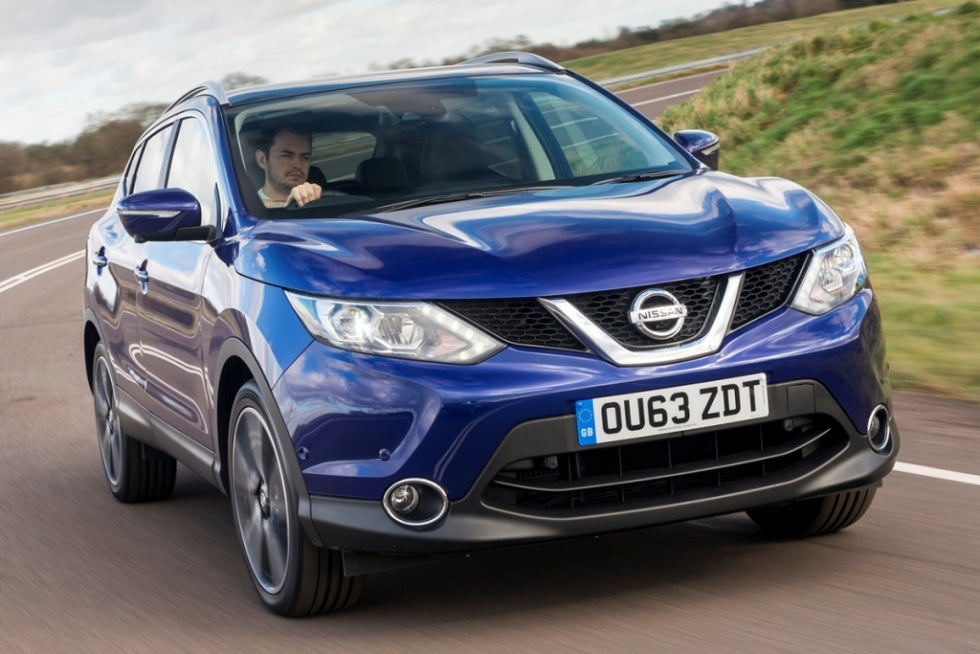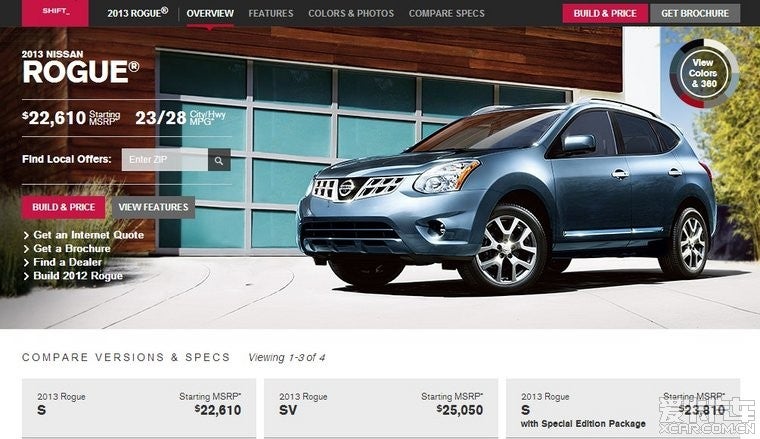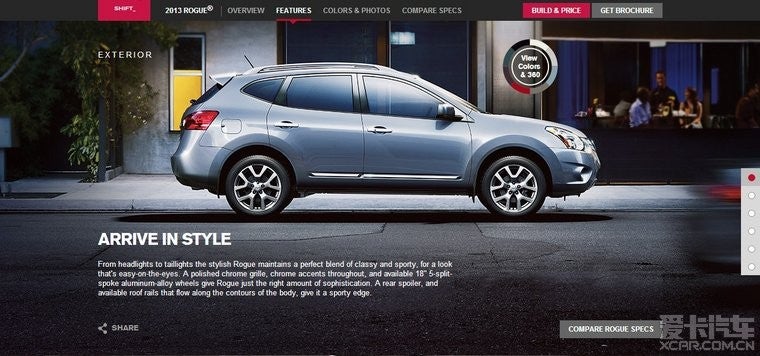The Qashqai is not offered in North American markets. Instead, Nissan offers the Nissan Rogue. Although larger and appearing to be a completely different model it is based on the same basic platform as the Qashqai / Xtrail with some visual similarities. In Mexico, the X-Trail and Rogue are both sold and the Qashqai is about to be offered in the Mexican Market.

The Nissan Rogue is a compact crossover SUV that debuted in October 2007[1] for the 2008 model year, produced by the Japanese automaker Nissan. It is the North American version of the European-designed Qashqai, known as the Dualis in Japan and Australia.

The Nissan Rogue made its debut at the North American International Auto Show in Detroit on January 7, 2007. It replaces the Nissan X-Trail in Canada as Nissan’s entry-level SUV and the body-on-frame Nissan Xterra in Mexico due to the Smyrna plant freeing capacity for the 2009 Suzuki Equator, but the Xterra continues on sale in the United States and Canada after being withdrawn from the Mexican market after the 2008 model year. An all-new version of the X-Trail, whose platform the Rogue shares, has been launched in Europe, Mexico and elsewhere, but there are no plans to market it in both USA and Canada.

The Nissan X-Trail is a compact crossover SUV produced by the Japanese automaker Nissan since 2001. It was one of Nissan’s first crossover SUVs and was released about the same time as several other companies competing car-based compact SUVs including the Suzuki Grand Vitara, Ford Escape and its Mazda Tribute sibling, the Hyundai Tucson, Honda CR-V and the Toyota RAV4. The X-Trail is positioned below the truck-based Xterra and Pathfinder and was never offered by dealerships in the United States. The first generation was available in Canada until it was replaced by the Rogue. However, both the Rogue and the X-Trail are sold in Mexico before, now rouge is replaced by Xtrail. The Rogue shares the same platform as the second-generation X-Trail and same to the Qashqai.
If you’ve just joined us from the NAFTA region, Nissan’s new, larger crossover for Europe probably looks a bit familiar. That’s because it’s on sale there already - as the Rogue. Nissan model names by market can get a bit confusing so I’ll try and add to that with the following explanation.
Previously, outside NAFTA, there was the smash-hit first generation Qashqai (aka Dualis in Australia and Japan and something unpronounceable in China). Built mainly in UK but also Japan and China. Five seats. For seven seats, there was, later, the Qashqai+2. For something bigger and a bit more butch for offroading, but just five seats, you moved up to the previous, second generation X-Trail.
In NAFTA (and the odd other market, such as Taiwan),there was the Japan-built Rogue, a bit bigger than the Qashqai but on the same platform, with a bigger petrol engine, a CVT auto and no diesel. The move up in NAFTA was to the Xterra.
Now, in Europe, we have a new generation Qashqai with just five seats and the old +2 model is gone. Build, again, is mainly here in the UK but Russian and Chinese production is planned and Japan is possible. But we can now get the third generation X-Trail with a seven seat option. Ours are made in Japan but production has also started in China and Russian output is planned - eventually nine plants will make this new one. It’ll eventually be sold - at the rate of 500,000 a year - in 190 countries.
In NAFTA, old Rogue continues, imported from Japan, as the Rogue Select, and our new X-Trail is their new Rogue, built in the US and, from the second half of 2014, also by Samsung in Korea. Like ours, that also has a seven seat option. And the step up remains the Xterra.
I have never ridden in or driven a previous generation X-Trail but the new one is much more stylish than its boxy predecessors - more Qashqai than Patrol.
Despite the softer looks, Nissan claims enhanced off road capabilities and sector-best levels of rear legroom, and highlights a unique second row seat sliding and reclining function, the new Connect infotainment/telematics system with suite of applications and the Safety Shield with an extended network of safety features.
The 3G X-Trail is built on the new, jointly-developed Renault-Nissan Alliance Common Module Family (CMF) platform and, for the UK, replaces the NAFTA Rogue’s 2.5-litre petrol I4 engine and CVT automatic with, initially, a 1.6-litre turbodiesel and two-wheel drive (new to the X-Trail line) or 4WD with six-speed manual and 2WD automatic transmission options.
“Less SUV and more crossover” is Nissan’s description of the new model which is 17mm longer (4,643mm) than the previous generation and has a 76mm longer wheelbase. It is also 30mm wider and 5mm lower while ground clearance remains 210mm. It’s 266mm longer than a Qashqai on a wheelbase 60mm longer and 100mm taller with 20mm more ground clearance.
The new model is also 90kg lighter than the model it replaces. Ultra high strength steel now accounts for 49% of body construction.
Rear doors open to 80 degrees for improved access and legroom is up 20%. The three seat rows are mounted theatre style, each a little higher than the one in front to improve the view forward. With judicious folding an item 2,600mm long can be carried and the tailgate is electric with remote operation.
That tailgate is constructed from plastic rather than steel while the front and rear bumper assemblies have been optimised for material thickness.
Inside, a redesigned combimeter has a drive-assist display, a large five-inch colour display screen located between the two main dials. This high-resolution touchscreen displays information from such items as the safety systems and navigator.
The centre console houses the latest NissanConnect system with a seven-inch high resolution screen and smartphone connectivity features.
The cabin has high quality materials, including chrome, piano black and leather with contrast stitching. Nissan said it examined every surface where the driver or passenger comes into contact with the car and, as a result, the door armrest pads and centre console pad are eight times thicker than sector rivals offer. A large centre storage box is big enough to take an iPad or 10-inch tablet.
The powered glass panoramic roof is said to be the biggest available in the class and the front half can be opened.
A double load floor provides nine flexible storage options. The cargo area can be positioned into upper and lower areas in a simple, single hand move. In its top position, the board can hold up to 10kg of luggage or 75kg in its middle position. This enables the user to store, for example, a stroller and large items below while creating a fully usable upper load surface for smaller, lighter items.
Tech
NissanConnect combines in-car navigation, information and entertainment with access to an evolving range of apps covering music, social networking, entertainment and travel.
Navigation integrates Google features from weather forecasts to the location of fuel stations, hotels, restaurants and so on. Send-to-car also allows drivers to plan a trip at home. The system includes Bluetooth audio streaming and mobile phone integration as well as aux and USB slots.
The five inch TFT colour display between the main dials incorporating 12 graphic displays accessible on rotation offering advice and warnings covering average and actual speeds, navigation turn-by-turn instructions, audio content, traffic sign recognition, eco driving advice and torque distribution settings in 4WD mode and more.
Around view monitor with intelligent park assist automatically measures the size of an available parallel parking space and actively steers into the space with the driver controlling forward and reverse motion. The system can also park in car park bays, with the driver benefitting from the bird’s eye view.
LED daytime running lights are standard and higher grade models have Bi-LED headlamps with full LED power for both dip and main beam producing a whiter, clearer light than Xenon bulbs while using 50% less power.
The Safety Shield package includes forward emergency braking, driver attention alert, traffic sign recognition, lane departure and blind spot warning, moving object detection and high beam assist.
Drivetrain
Four wheel versions adopt Nissan’s electronic four-wheel drive system, All Mode 4x4-i controlled via a rotary switch on the centre console, offering a choice between two-wheel drive, auto mode or lock offering permanent four wheel drive.
In the ‘default’ auto mode, the system constantly monitors throttle opening, engine speed and torque to anticipate wheel spin and to distribute torque between front and rear axles as needed, at speeds of up to 80km/h (50mph).
Above that speed, the system reacts to wheelspin, again shifting drive rearwards to restore traction as required. For tricky conditions and at low speeds, lock gives permanent four-wheel drive.
Four other electronic systems are active ride control which monitors the road surface to detect undulations which could potentially upset the pitch of the car body and alters the damping to compensate, active engine brake which, on CVT versions, adds a degree of engine braking while cornering or when decelerating to a standstill and active trace control which monitors speed, steering angle, throttle opening and braking effort and brakes wheels individually, as required, to reduce understeer and help the driver steer a safer path through bends: it is said to be particularly effective on slippery, wet roads.
Hill start assist is also included.
The X-Trail will be launched in the UK with the Renault-Nissan Alliance dCi 130PS turbodiesel engine with a choice of two and four-wheel drive and six speed manual transmission or an optional ‘XTronic’ CVT automatic gearbox for 2WD only. A 163PS 1.6-litre DIG-T turbocharged petrol engine will be added in 2015. The outgoing line had a 2.5-litre petrol and two-litre diesels.
The new XTronic gearbox mimics the behaviour of traditional, multi-ratio automatic gearboxes during hard acceleration, with stepped changes and worked pretty well. I thought the 1.6-litre diesel was a bit small for a vehicle of this size and it needed plenty of manual gearbox work to keep it in the right torque range for rapid progress and decent acceleration.
Spec
UK buyers will be offered Nissan’s familar Visia, Acenta, n-tec and Tekna specification packages.
All grades have air conditioning, alloy wheels and six airbags, LED daytime running lights, five-inch colour combimeter display, Bluetooth with microphone, cruise control and speed limiter, hill start assist, sliding and reclining rear seats and the luggage board system.
Range-topping Tekna models have bi-LED headlamps, leather seats, electrically-adjustable driver’s seat, front and rear parking sensors, 19-inch alloy wheels, intelligent key with engine start button, forward emergency braking, lane departure warning, high beam assist and traffic sign recognition.
Prices start at GBP22,995 with CVT adding GBP1,350, 4WD (instead) GBP1,700 and seven seats GBP700.
Nissan said UK servicing and maintenance costs should be down 12-15% versus the old model with insurance down as many as 10 groups, a 30% reduction in fuel consumption and a fleet-friendly CO2 cut of 39g. Residual values are up an estimated 9%.
Volume is estimated at 9-10,000 in a full year with the 2WD manual taking 45% (and opening up a whole new market to the X-Trail which previously was 4WD only), 4WD 43% and 2WD CVT auto 12%.
Trim choices are expected to be Tekna 41% (UK buyers like lots of goodies and nice finishes), n-tec 35%, Acenta 19% and Visia 5%.
About 30% of buyers are expected to opt for seven chairs.
没有评论:
发表评论